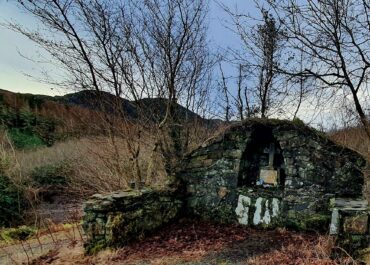Church, Clonbeg Glebe, Co. Donegal
Hidden amongst ivy in the townland of Clonbeg Glebe lies the ruined shell of a 17th century church, its weathered stone walls standing as a quiet testament to centuries of rural worship.
Church, Clonbeg Glebe, Co. Donegal
The building, measuring just over 12 metres long by 4 metres wide internally, was likely constructed as a chapel of ease to serve the local community around Clondahorky. Though historian Bigger mistakenly identified it in 1909 as the site of a Third Order Regular foundation at Ballymacswiney, the church appears to have served its congregation until around 1752, when a new church was built at nearby Ballymore and this older site was abandoned.
Today, only fragments of the original structure remain standing. The rubble stone walls, now ranging from 1.5 to 2.5 metres in height, still retain some architectural details that hint at the building’s past. Two windows with splayed openings and segment-headed rear arches survive in the north and south walls, their design typical of 17th century ecclesiastical architecture. At the western end of the south wall, traces of the original doorway can still be seen, complete with indications where a timber door frame once stood. A memorial stone dated 1679, once recorded as being attached to the inner face of the south wall, confirms the church was actively used during that period.
The ruins sit within an overgrown graveyard that has slowly reclaimed much of the site. The cemetery wall has actually incorporated parts of the old church structure; it overlies the remaining stretch of the north wall and takes over completely at the northeast corner. This gradual blending of church and graveyard walls speaks to the organic way these rural religious sites evolved and eventually declined, leaving behind these atmospheric ruins that punctuate the Donegal landscape.


